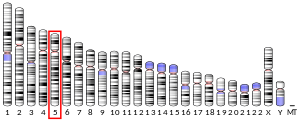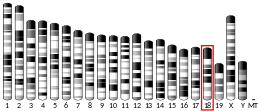Protein-coding gene in the species Homo sapiens
| CXXC5 |
|---|
|
| Identifiers |
|---|
| Aliases | CXXC5, CF5, RINF, WID, HSPC195, CXXC finger protein 5 |
|---|
| External IDs | OMIM: 612752; MGI: 1914643; HomoloGene: 9517; GeneCards: CXXC5; OMA:CXXC5 - orthologs |
|---|
| Gene location (Human) |
|---|
 | | Chr. | Chromosome 5 (human)[1] |
|---|
| | Band | 5q31.2 | Start | 139,647,299 bp[1] |
|---|
| End | 139,683,882 bp[1] |
|---|
|
| Gene location (Mouse) |
|---|
 | | Chr. | Chromosome 18 (mouse)[2] |
|---|
| | Band | 18|18 B2 | Start | 35,962,450 bp[2] |
|---|
| End | 35,994,741 bp[2] |
|---|
|
| RNA expression pattern |
|---|
| Bgee | | Human | Mouse (ortholog) |
|---|
| Top expressed in | - pancreatic ductal cell
- renal medulla
- inferior ganglion of vagus nerve
- medulla oblongata
- ventral tegmental area
- superior vestibular nucleus
- cerebellum
- nasal epithelium
- pons
- cerebellar hemisphere
|
| | Top expressed in | - Epithelium of choroid plexus
- tail of embryo
- lens
- ciliary body
- iris
- cerebellar cortex
- epithelium of lens
- islet of Langerhans
- Rostral migratory stream
- vestibular membrane of cochlear duct
|
| | More reference expression data |
|
|---|
| BioGPS | |
|---|
|
| Gene ontology |
|---|
| Molecular function | - sequence-specific DNA binding
- DNA binding
- zinc ion binding
- transcription factor binding
- protein binding
- signal transducer activity
- metal ion binding
| | Cellular component | - nucleus
- nucleoplasm
- cytoplasm
- cytosol
| | Biological process | - positive regulation of I-kappaB kinase/NF-kappaB signaling
- negative regulation of transcription by RNA polymerase II
- transcription, DNA-templated
- signal transduction
| | Sources:Amigo / QuickGO |
|
| Orthologs |
|---|
| Species | Human | Mouse |
|---|
| Entrez | | |
|---|
| Ensembl | | |
|---|
| UniProt | | |
|---|
| RefSeq (mRNA) | NM_016463
NM_001317199
NM_001317200
NM_001317201
NM_001317202
|
|---|
NM_001317203
NM_001317204
NM_001317205
NM_001317206
NM_001317207
NM_001317208
NM_001317209
NM_001317210
NM_001317211 |
| |
|---|
NM_133687
NM_001357458
NM_001357459 |
|
|---|
| RefSeq (protein) | NP_001304128
NP_001304129
NP_001304130
NP_001304131
NP_001304132
|
|---|
NP_001304133
NP_001304134
NP_001304135
NP_001304136
NP_001304137
NP_001304138
NP_001304139
NP_001304140
NP_057547 |
| |
|---|
NP_598448
NP_001344387
NP_001344388 |
|
|---|
| Location (UCSC) | Chr 5: 139.65 – 139.68 Mb | Chr 18: 35.96 – 35.99 Mb |
|---|
| PubMed search | [3] | [4] |
|---|
|
| Wikidata |
| View/Edit Human | View/Edit Mouse |
|
CXXC-type zinc finger protein 5 is a protein that is encoded by the CXXC5 gene in humans.[5][6][7][8]
As indicated by its name, the CXXC5 plays a role as a transcription factor in the nucleus of cells, and involved in myelopoiesis, endothelial differentiation, vessel formation, and oligodendrocyte differentiation.[9][10][7]
The CXXC5 is also characterized as a negative feedback regulator of the Wnt/β-catenin signaling pathway functioning by direct interaction with the Dishevelled (Dvl) protein in the cytosol.[6][9][11][12][13] The cytosolic overexpression of CXXC5 was induced by several pathophysiological conditions, such as osteoporosis, alopecia, senescence of growth plate, cutaneous wound, and restoration of the suppressed Wnt/β-catenin signaling by blockade of its Dvl binding function improved the pathological features as observed in Cxxc5-/- mice.[9][12][13][14] These results indicate that the Dvl binding with cytosolic CXXC5 could be a target for the development of agents for treating alopecia, acute wound, and short stature in childhood and adolescence, which exhibit suppressed Wnt/β-catenin signaling by cytosolic CXXC5 overexpression of the responsible tissue cells.[11][13][15] The CXXC5-Dvl protein-protein interaction (PPI) as a target for development of agents in hair loss or acute wound was also confirmed by construction and testing the function of PTD-DBM, a peptide inhibiting the CXXC5-Dvl PPIl.[11][13]
The improvement of abnormalities by the CXXC5-Dvl PPI inhibitor is attributed to restoration of damaged tissues by activating the stem cells through restorative activation of the suppressed Wnt/β-catenin signaling and its target genes involving regeneration.
References
- ^ a b c GRCh38: Ensembl release 89: ENSG00000171604 – Ensembl, May 2017
- ^ a b c GRCm38: Ensembl release 89: ENSMUSG00000046668 – Ensembl, May 2017
- ^ "Human PubMed Reference:". National Center for Biotechnology Information, U.S. National Library of Medicine.
- ^ "Mouse PubMed Reference:". National Center for Biotechnology Information, U.S. National Library of Medicine.
- ^ Zhang QH, Ye M, Wu XY, Ren SX, Zhao M, Zhao CJ, et al. (October 2000). "Cloning and functional analysis of cDNAs with open reading frames for 300 previously undefined genes expressed in CD34+ hematopoietic stem/progenitor cells". Genome Research. 10 (10): 1546–60. doi:10.1101/gr.140200. PMC 310934. PMID 11042152.
- ^ a b Andersson T, Södersten E, Duckworth JK, Cascante A, Fritz N, Sacchetti P, et al. (February 2009). "CXXC5 is a novel BMP4-regulated modulator of Wnt signaling in neural stem cells". The Journal of Biological Chemistry. 284 (6): 3672–81. doi:10.1074/jbc.M808119200. PMID 19001364.
- ^ a b Pendino F, Nguyen E, Jonassen I, Dysvik B, Azouz A, Lanotte M, et al. (April 2009). "Functional involvement of RINF, retinoid-inducible nuclear factor (CXXC5), in normal and tumoral human myelopoiesis". Blood. 113 (14): 3172–81. doi:10.1182/blood-2008-07-170035. PMID 19182210.
- ^ "Entrez Gene: CXXC5 CXXC finger 5".
- ^ a b c Kim HY, Yoon JY, Yun JH, Cho KW, Lee SH, Rhee YM, et al. (June 2015). "CXXC5 is a negative-feedback regulator of the Wnt/β-catenin pathway involved in osteoblast differentiation". Cell Death and Differentiation. 22 (6): 912–20. doi:10.1038/cdd.2014.238. PMC 4423189. PMID 25633194.
- ^ Kim HY, Yang DH, Shin SW, Kim MY, Yoon JH, Kim S, et al. (February 2014). "CXXC5 is a transcriptional activator of Flk-1 and mediates bone morphogenic protein-induced endothelial cell differentiation and vessel formation". FASEB Journal. 28 (2): 615–26. doi:10.1096/fj.13-236216. PMID 24136587. S2CID 23959096.
- ^ a b c Lee SH, Kim MY, Kim HY, Lee YM, Kim H, Nam KA, et al. (June 2015). "The Dishevelled-binding protein CXXC5 negatively regulates cutaneous wound healing". The Journal of Experimental Medicine. 212 (7): 1061–80. doi:10.1084/jem.20141601. PMC 4493411. PMID 26056233.
- ^ a b Kim HY, Choi S, Yoon JH, Lim HJ, Lee H, Choi J, et al. (April 2016). "Small molecule inhibitors of the Dishevelled-CXXC5 interaction are new drug candidates for bone anabolic osteoporosis therapy". EMBO Molecular Medicine. 8 (4): 375–87. doi:10.15252/emmm.201505714. PMC 4818757. PMID 26941261.
- ^ a b c d Lee SH, Seo SH, Lee DH, Pi LQ, Lee WS, Choi KY (November 2017). "Targeting of CXXC5 by a Competing Peptide Stimulates Hair Regrowth and Wound–Induced Hair Neogenesis". The Journal of Investigative Dermatology. 137 (11): 2260–2269. doi:10.1016/j.jid.2017.04.038. PMID 28595998.
- ^ Choi S, Kim HY, Cha PH, Seo SH, Lee C, Choi Y, et al. (April 2019). "CXXC5 mediates growth plate senescence and is a target for enhancement of longitudinal bone growth". Life Science Alliance. 2 (2): e201800254. doi:10.26508/lsa.201800254. PMC 6458850. PMID 30971423.
- ^ Choi S, Kim HY, Cha PH, Seo SH, Lee C, Choi Y, et al. (April 2019). "CXXC5 mediates growth plate senescence and is a target for enhancement of longitudinal bone growth". Life Science Alliance. 2 (2): e201800254. doi:10.26508/lsa.201800254. PMC 6458850. PMID 30971423.
Further reading
- Rual JF, Venkatesan K, Hao T, Hirozane-Kishikawa T, Dricot A, Li N, et al. (October 2005). "Towards a proteome-scale map of the human protein-protein interaction network". Nature. 437 (7062): 1173–8. Bibcode:2005Natur.437.1173R. doi:10.1038/nature04209. PMID 16189514. S2CID 4427026.
- Colland F, Jacq X, Trouplin V, Mougin C, Groizeleau C, Hamburger A, et al. (July 2004). "Functional proteomics mapping of a human signaling pathway". Genome Research. 14 (7): 1324–32. doi:10.1101/gr.2334104. PMC 442148. PMID 15231748.
- Matsuda A, Suzuki Y, Honda G, Muramatsu S, Matsuzaki O, Nagano Y, et al. (May 2003). "Large-scale identification and characterization of human genes that activate NF-kappaB and MAPK signaling pathways". Oncogene. 22 (21): 3307–18. doi:10.1038/sj.onc.1206406. PMID 12761501.
- Yu W, Andersson B, Worley KC, Muzny DM, Ding Y, Liu W, et al. (April 1997). "Large-scale concatenation cDNA sequencing". Genome Research. 7 (4): 353–8. doi:10.1101/gr.7.4.353. PMC 139146. PMID 9110174.
- Andersson B, Wentland MA, Ricafrente JY, Liu W, Gibbs RA (April 1996). "A "double adaptor" method for improved shotgun library construction". Analytical Biochemistry. 236 (1): 107–13. doi:10.1006/abio.1996.0138. PMID 8619474.
External links
- Human CXXC5 genome location and CXXC5 gene details page in the UCSC Genome Browser.
- GRCh38: Ensembl release 89: ENSG00000171604 - Ensembl, May 2017
- GRCm38: Ensemble release 89: ENSMUSG00000046668 - Ensembl, May 2017
- "Human PubMed Reference" National Center for Biotechnology Information, U.S. National Library of Medicine.
- "Human PubMed Reference" National Center for Biotechnology Information, U.S. National Library of Medicine.

















